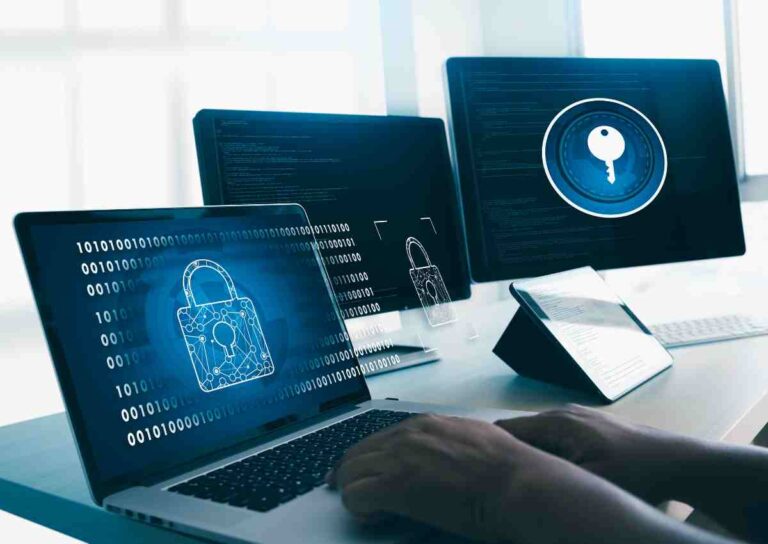Where online accounts are gateways to our personal and professional lives, securing these virtual vaults is paramount. Two-factor authentication (2FA) emerges as a critical fortification in this context. Unlike the traditional security method, where access is granted solely through a username and password, 2FA introduces an additional layer of security, making it significantly harder for attackers to breach your digital presence. This robust approach to security is not just an option but a necessity for anyone serious about protecting their online identity.
For individuals and organizations keen on fortifying their digital assets, understanding and implementing two-factor authentication methods is crucial. This guide serves as a comprehensive introduction to 2FA, tailored for those aspiring to enhance their digital security.

How does two-factor authentication work?
Two-factor authentication is a security process in which users provide two different authentication factors to verify themselves. This method is a crucial part of an extra layer of security that ensures that the person trying to gain access to an online account is who they claim to be. First, a user will enter their username and password. Then, instead of immediately gaining access, they will be required to provide another piece of information—the second factor.
This additional layer of security that 2FA provides is what makes it significantly more effective than traditional single-factor authentication (SFA), where the only barrier to entry is something you know (typically a password). With 2FA, even if an attacker manages to learn your password, the chances of them also having access to your second factor are highly unlikely, thereby reducing the risk of unauthorized access and potential compromise.
Authentication Factors
In the realm of two-factor authentication (2FA), understanding the underlying authentication factors is fundamental to appreciating its robust security model. Authentication factors are the different categories of information or credentials that individuals use to verify their identity. In the context of 2FA, these factors can be broadly categorized into three types:
- Something you know: This includes information that only the user should know, such as a password or a PIN. It is the traditional authentication factor used in single-factor authentication (SFA) systems.
- Something you have: This involves a physical item that the user possesses, like a security token, smart card, or mobile device. This factor adds an extra layer of security, as even if an attacker knows the password, they would still need the physical item to gain access.
- Something You Are: This refers to biometric data, such as fingerprint recognition, retina scans, or facial recognition. Biometric authentication provides a unique and highly secure method, as it is challenging for an attacker to replicate or fake these physical attributes.
The importance of using two different authentication factors lies in the concept of creating a multi-layered defense against unauthorized access. Relying on a combination of factors ensures that even if one factor is compromised, the other(s) act as a barrier, maintaining the integrity of the authentication process. This layered approach significantly raises the difficulty level for attackers attempting to breach the security of an account or system.
The Authentication Process
Within the realm of two-factor authentication (2FA), the authentication process unfolds as a sophisticated mechanism designed to fortify access controls. It encompasses a variety of methods, each contributing to the establishment of a secure digital perimeter. Here’s an exploration of the diverse authentication methods nested within the 2FA framework:
- Knowledge-Based Authentication (Something You Know): Users authenticate themselves by providing information only they should know, such as passwords or PINs.
- Token-Based Authentication (Something You Have): Users use physical tokens like SMS codes, hardware tokens, or smart cards to verify their identity.
- Biometric Authentication (Something You Are): Utilizing unique physical characteristics, such as fingerprints or facial features, for identity verification.
- Authentication Apps and Security Keys: Mobile apps generate time-sensitive codes, and security keys provide a physical device for verification.
The introduction of multi-factor authentication (MFA) further enhances the security paradigm. MFA extends beyond the two factors and incorporates additional layers of verification, creating a more intricate defense mechanism. It is an acknowledgment that as technology advances, so too must our security measures. MFA can include a combination of knowledge-based, token-based, and biometric authentication methods, reinforcing the overarching principle of layered security in authentication processes. This adaptive approach ensures a robust defense against a spectrum of potential threats, from password breaches to sophisticated cyberattacks.
Types of Two-Factor Authentication
In the landscape of two-factor authentication (2FA), various methods are employed to ensure the integrity and security of the authentication process. These methods can be broadly categorized into different types, each serving as a key component in the multi-layered security strategy.
Knowledge-Based Authentication (Something You Know)
Knowledge-based authentication represents the most familiar facet of 2FA, relying on information that only the user is expected to know. This category primarily includes:
- Passwords: A string of characters that the user must remember and enter to gain access. Passwords are the most common form of knowledge-based authentication and form the first line of defense in most security protocols.
- PINs (Personal Identification Numbers): Typically a numerical code, PINs are another form of knowledge-based authentication often used in conjunction with passwords, adding an extra layer of security.
While passwords and PINs are effective to an extent, they can be vulnerable to various attack methods like phishing or social engineering. Hence, they are usually paired with another type of authentication factor in 2FA systems for enhanced security.
Token-Based Authentication (Something You Have)
Token-based authentication introduces a physical or digital item that the user must possess to gain access, adding a significant hurdle for potential attackers.
SMS Tokens
- SMS tokens involve sending a code via text message to the user’s mobile phone. Once the user receives this code, they enter it into the system to complete the authentication process.
- This method leverages the user’s possession of a specific device (their phone), making it unlikely for an unauthorized user to receive the code.
- However, SMS tokens can be susceptible to interception or redirection, although they still offer a substantial security upgrade over standalone passwords.
Hardware Tokens
- Hardware tokens are physical devices that generate a code or key used in the authentication process. These can be key fobs, USB devices, or smart cards.
- The token generates a new code at fixed intervals, which the user enters during the login process. This code, paired with the user’s knowledge-based information (like a password), completes the 2FA process.
- The use of hardware tokens in 2FA is considered highly secure as it requires physical possession of the token, drastically reducing the chances of unauthorized access.
Both SMS and hardware tokens enhance security by ensuring that even if a password or PIN is compromised, an attacker still lacks the necessary second factor—the token, be it digital (SMS) or physical (hardware)—to gain access. This dual requirement is at the heart of why 2FA significantly elevates the security of user accounts and sensitive data.
Biometric Authentication (Something You Are)
Biometric authentication represents a cutting-edge facet of two-factor authentication (2FA), leveraging unique physical characteristics to verify a user’s identity. In this context, biometric data serves as the “something you are” factor, adding an unparalleled layer of security. One prominent form of biometric authentication is facial recognition, where distinctive facial features are used for identity verification within 2FA.
- Facial Recognition: This method involves capturing and analyzing facial features, such as the geometry of the face, to verify a user’s identity. Cameras or sensors capture unique facial characteristics, and advanced algorithms compare these features to stored templates to grant or deny access.
Biometric authentication, particularly facial recognition, is lauded for its accuracy and convenience. Since facial features are distinctive to each individual, the chances of a false positive or negative are significantly reduced. Additionally, it provides a seamless and frictionless user experience, eliminating the need for users to remember additional codes or carry physical tokens.
However, it’s important to note that the security of biometric authentication relies on the safeguarding of the biometric data itself. Storing and transmitting this data in a secure manner is crucial to prevent unauthorized access or potential misuse.
Authentication Apps and Security Keys
In the realm of 2FA, authenticator apps play a pivotal role in enhancing the security landscape. These mobile applications generate time-sensitive codes that serve as the second factor in the authentication process.
- Role of Authenticator Apps: Authenticator apps, such as Google Authenticator or Authy, generate one-time passcodes (OTPs) that are synchronized with the authentication server. Users enter the current OTP displayed in the app during the login process.
- Authenticator apps provide an added layer of security because the codes change regularly, usually every 30 seconds. Even if an attacker somehow obtains a code, it becomes useless after a short period, reducing the risk of compromise.
- The use of authenticator apps is versatile, as they don’t rely on network connectivity like SMS tokens, making them a reliable option even in areas with poor or no mobile network coverage.
Security Keys
- Security keys are physical devices that offer a tangible and highly secure method of authentication in 2FA. Common forms include USB keys or NFC-enabled devices.
- Benefits of Security Keys in 2FA:
- Physical Possession: Security keys require physical possession, adding a layer of security that is resistant to remote attacks.
- Phishing Resistance: Unlike codes generated by apps or sent via SMS, security keys are not susceptible to phishing attacks since they can’t be easily replicated or intercepted.
- Ease of Use: Users simply need to insert the security key into a compatible device and press a button to complete the authentication process, providing a user-friendly experience.
Best Practices for Two-Factor Authentication
Securing your digital presence through two-factor authentication (2FA) is not only about adopting the technology but also about implementing it effectively. To maximize the effectiveness of 2FA, it is crucial to adhere to best practices that ensure a robust and reliable security framework.
Choosing the Right Methods
Selecting the most suitable 2FA methods is a critical decision that varies based on individual needs, preferences, and the level of security required for a particular application or system.
- Evaluate the Options: Consider the available 2FA methods such as knowledge-based authentication, token-based authentication, biometric authentication, authenticator apps, and security keys. Each method has its strengths and weaknesses, so evaluating them based on your specific use case is essential.
- Adapt to Context: Some 2FA methods may be more appropriate for certain scenarios. For example, while biometric authentication might be convenient for mobile devices, hardware tokens could provide additional security for critical systems.
- Consider User Experience: Balancing security with user convenience is key. Opt for methods that strike the right balance, ensuring that users can easily adopt and adhere to the 2FA process without significant friction.
- Stay informed: As technology evolves, new 2FA methods may emerge. Stay informed about the latest advancements to continuously enhance your security posture.
Device Security
Ensuring the security of the devices used for 2FA is an often overlooked but crucial aspect of maintaining a robust security posture.
- Importance of Securing Mobile Devices: Many 2FA methods, such as authenticator apps and SMS tokens, involve the use of mobile devices. Securing these devices is paramount.
- Use Strong Passcodes: Set strong passcodes or PINs for your mobile devices. This serves as the first layer of security before the second factor comes into play.
- Enable Device Lock: Implement device locking mechanisms, such as fingerprint or facial recognition, to prevent unauthorized access to your mobile device.
- Regular Updates: Keep your devices and applications up-to-date. Security patches and updates often address vulnerabilities that could be exploited by attackers.
- Device Management: If using company-issued devices for 2FA, ensure proper device management policies are in place. This includes the ability to remotely wipe or lock a device in case of loss or theft.
The Future of Authentication
As we navigate through an ever-evolving digital landscape, the realm of authentication is rapidly transforming, introducing innovative technologies that aim to redefine how we secure our online presence.
Emerging Technologies
The future of authentication is poised to witness a paradigm shift with the advent of emerging technologies such as passwordless authentication and adaptive authentication. These advancements are not only enhancing security but are also streamlining the user experience.
- Passwordless Authentication: This technology is a significant leap forward, moving away from traditional password-based systems. Passwordless methods use alternatives like biometrics (fingerprints or facial recognition), security tokens, or one-time passcodes sent via SMS or email. The key advantage here is the elimination of passwords, which are often the weakest link due to their susceptibility to being stolen, forgotten, or compromised.
- Adaptive Authentication: Also known as risk-based authentication, adaptive authentication adds an intelligent layer to the authentication process. It evaluates various risk factors, such as the user’s location, device being used, and network security, to determine the level of authentication needed. For instance, a login attempt from an unfamiliar location might trigger additional security checks. This method offers a dynamic approach, balancing security and convenience based on real-time risk assessment.
These technologies not only promise enhanced security but also a more intuitive and frictionless user experience. By leveraging advanced algorithms, data analytics, and machine learning, they are set to redefine the standards of user authentication.
Key Takeaways
In summary, two-factor authentication (2FA) has emerged as a pivotal security mechanism for protecting online accounts and sensitive data. Its importance cannot be overstated in an era where digital threats are increasingly sophisticated.
- Enhanced Security: 2FA adds a critical layer of security beyond just a username and password, making it significantly harder for attackers to gain unauthorized access.
- Diverse Methods: From SMS tokens and hardware tokens to biometric data and authenticator apps, 2FA offers a range of methods to cater to different security needs and preferences.
- Best Practices: Choosing the right 2FA method, ensuring device security, and staying updated with the latest trends are key practices for maximizing the effectiveness of 2FA.
- Future Trends: The future of authentication is heading towards more adaptive and user-friendly methods, with technologies like passwordless and adaptive authentication leading the way.
What is two-factor authentication (2FA)?
Two-factor authentication (2FA) is a security process that requires users to provide two different authentication factors to verify their identity. This typically involves a combination of something the user knows (like a password) and something the user has (like a mobile device or security token).
Why is 2FA necessary?
A: 2FA is necessary because it adds an extra layer of security beyond traditional username and password combinations. This reduces the risk of unauthorized access and compromises, as even if one factor is compromised, the other provides an additional barrier.
What are the different authentication factors in 2FA?
A: The three main authentication factors in 2FA are something you know (e.g., passwords), something you have (e.g., tokens or mobile devices), and something you are (e.g., biometric data like fingerprints or facial recognition).
Are all 2FA methods equally secure?
A: The security of 2FA methods varies, and their effectiveness depends on the specific context and implementation. Methods like biometric authentication and hardware tokens are generally considered more secure than knowledge-based methods like passwords.
Can 2FA be bypassed or hacked?
A: While no system is entirely foolproof, 2FA significantly reduces the risk of unauthorized access. Bypassing or hacking 2FA requires compromising both authentication factors, which is a challenging task for attackers.
How does biometric authentication work in 2FA?
A: In 2FA, biometric authentication involves using unique physical characteristics like fingerprints or facial features for identity verification. These characteristics serve as the “something you are” factor, adding an extra layer of security.
- More Post: Common Cybersecurity Threats and How to Mitigate Them
- More Post: The Importance of Cybersecurity in the Digital Age
Conclusion
In conclusion, the significance of two-factor authentication (2FA) cannot be overstated in the ongoing battle against unauthorized access and compromise. As the digital landscape continues to evolve, the importance of fortifying our online accounts and sensitive data becomes increasingly crucial.
Recap of 2FA’s Significance:
- Enhanced Security: 2FA provides an extra layer of security by requiring two different authentication factors, reducing the risk of unauthorized access.
- Diverse Methods: From knowledge-based authentication to biometrics and tokens, 2FA offers a range of methods to suit different security needs.
- Adaptability: The future of authentication, including technologies like passwordless and adaptive authentication, continues to evolve for more secure and user-friendly experiences.
As we navigate the digital landscape, the implementation of 2FA stands as a critical step towards securing our online presence. Readers are strongly encouraged to adopt and implement 2FA across their digital accounts. By doing so, not only do individuals safeguard their personal and professional information, but they also contribute to the broader initiative of creating a more secure and resilient online environment. Embrace 2FA and fortify your digital defenses for a safer online experience.






